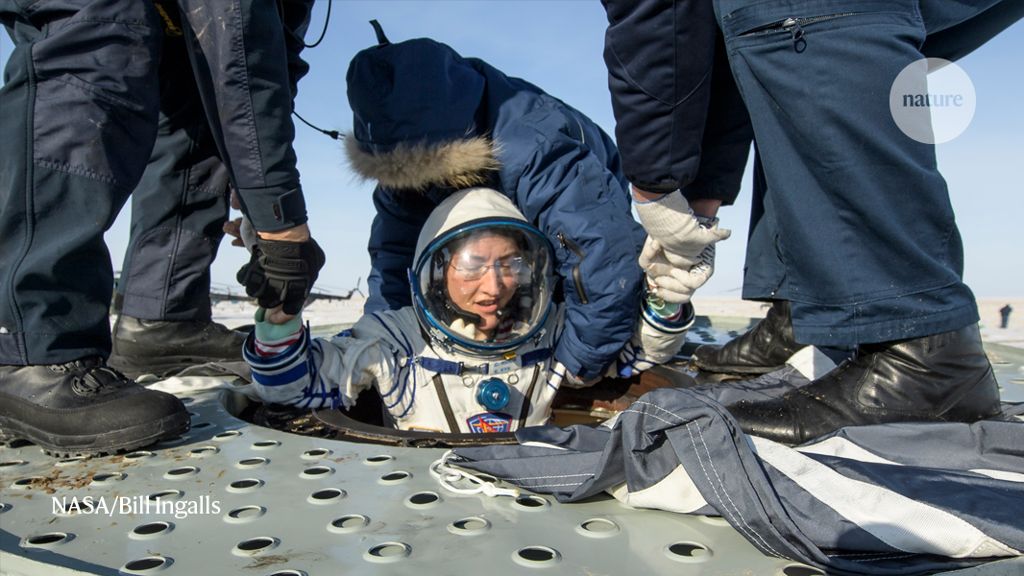Down to Earth. NASA astronaut Christina Koch emerges from the Soyuz spacecraft, which landed in Kazakhstan on 6 February. Koch returned to Earth after spending 328 days on board the International Space Station (ISS), setting the record for the longest single spaceflight by a woman. Last October, Koch and NASA colleague Jessica Meir performed history’s first all-female spacewalk, to repair a faulty battery unit on the ISS.
Cutting cancer. This close-up shot of a cancer cell that has been cut open using an ion beam was taken by biomedical engineer Nick Moser at Imperial College London and cancer biologist Chris Bakal at the Institute of Cancer Research (ICR) in London, and was shortlisted for the science and medical imaging competition run by the ICR. The beam has blasted part of the cell away to reveal a cross section and has cut into the silica substrate, creating a triangular shape. The technique, called ion-beam milling, allows researchers to look inside cancer cells in unprecedented detail.
Coronavirus captured. This image shows a collection of particles (coloured pink) of the new coronavirus, SARS-CoV-2, emerging from an infected cell in a scanning-electron-microscope image. The coronavirus causes the respiratory disease COVID-19, which is spreading rapidly around the world and has infected tens of thousands of people worldwide. The virus, which emerged in the Chinese city of Wuhan in December, belongs to the same family as the pathogen that causes severe acute respiratory syndrome, or SARS.
Red world. An analysis published last month of data captured by NASA’s New Horizons spacecraft has revealed a detailed picture of the distant Solar System object known as Arrokoth. The 36-kilometre-long object, which lies in the frigid Kuiper belt, is extremely red, probably because cosmic rays have blasted its surface to create red organic molecules. Its two lobes are thought to have merged gently in the early days of the Solar System, at least four billion years ago.
Bird cloud. A weather radar in Key West, Florida, picked up a flock of hundreds of migrating birds, which appeared as a storm-like concentration of brightly coloured dots. Key West’s weather forecast office tweeted that the radar service had had a “busy night, but not because of weather” and called the sight “the most impressive display of migratory birds so far this year”. It is the time of year when several bird species fly home after spending the winter in warmer regions farther south. Dark-blue areas of rain can also be seen on the radar image.
Orchestral operation. Musician Dagmar Turner plays the violin during surgery to remove a tumour from the right frontal lobe of her brain, close to an area that controls movement in her left hand. The surgeons at King’s College Hospital in London asked her to play while they operated, to ensure they didn’t inadvertently damage parts of the brain involved in precise hand movements and coordination. “We knew how important the violin is to Dagmar so it was vital that we preserved function in the delicate areas of her brain that allowed her to play,” said consultant neurosurgeon Keyoumars Ashkan. “We managed to remove over 90% of the tumour, including all the areas suspicious of aggressive activity, while retaining full function in her left hand.”
Fading star. This image shows the unprecedented dimming of the star Betelgeuse — the right ‘shoulder’ in the constellation of Orion — captured by the European Southern Observatory’s Very Large Telescope. Betelgeuse is normally one of the ten brightest stars in the night sky, but it began getting dimmer in October last year. By mid-February, it had lost more than two-thirds of its brilliance — a difference noticeable to the naked eye. The pictures show the star in January 2019 (left) and December 2019 (right). The reasons for the dimming continue to puzzle astronomers, but the star has since been getting brighter.
Spinning a yarn. Researchers weave a yarn out of human extracellular matrix (ECM), the supportive network that normally surrounds cells in a living tissue. Because ECM is rich in the structural protein collagen, it can be used to make sheets of material that are thin but have a high tensile strength. Scientists at the University of Bordeaux extracted ECM from lab-grown human cells and used it to make strands of tough yarn that can be knitted or woven into ‘human textiles’. They are hoping to use this approach to make materials that can be used to repair damaged blood vessels.







